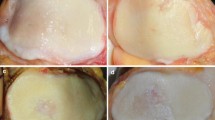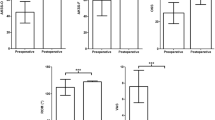Abstract
Purpose
While the classical indications and contraindications for unicondylar knee arthroplasty (UKA) are widely accepted there is not yet consensus if patients with partial thickness cartilage loss (PTCL) are equally suited for treatment with UKA. The aim of our study was to determine if patients with partial thickness cartilage loss do equally well after treatment with UKA.
Methods
The study retrospectively analyzed the clinical results as well as the survival rates of 64 patients treated with UKA with the medial Oxford knee system. 32 patients had shown PTCL on preoperative radiographs, while the matched control group presented with full thickness cartilage loss (FTCL) medially. Outcome parameters were the Oxford Knee Score (OKS), the American Knee Society Score (AKS), and radiographic analysis.
Results
Postoperative improvement in OKS was 16 (SD 9.0) for patients with PTCL and 17 (SD 8.1) for patients with FTCL. There were no significant differences in the clinical scores between the two groups. Five Patients with PTCL had reoperation whereas there were only two in the bone on bone group. Cumulative survival at 5 years for all revisions was 84 % (95 % CI 72–92 %) for the PTCL group and 97 % (95 % CI 92–100 %) for the FTCL group. This difference was not yet significant (log rank: p = 0.095).
Conclusions
Patients with PTCL are not equally suited for treatment with UKA like patients with bone on bone. Although PTCL has equal clinical results, it was associated with higher revision rates in our series.







Similar content being viewed by others
References
Price AJ, Waite JC, Svard U (2005) Long-term clinical results of the medial Oxford unicompartmental knee arthroplasty. Clin Orthop Relat Res 435:171–180
Newman J, Pydisetty RV, Ackroyd C (2009) Unicompartmental or total knee replacement: the 15-year results of a prospective randomised controlled trial. Bone Joint J 91(1):52–57
Manzotti A, Confalonieri N, Pullen C (2007) Unicompartmental versus computer-assisted total knee replacement for medial compartment knee arthritis: a matched paired study. Int Orthop 31(3):315–319
Murray DW, Goodfellow JW, O’Connor JJ (1998) The Oxford medial unicompartmental arthroplasty: a 10-year survival study. Bone Joint J 80(6):983–989
Pandit H et al (2011) Unicompartmental knee replacement for patients with partial thickness cartilage loss in the affected compartment. Knee 18(3):168–171
Niinimaki TT et al (2011) Unicompartmental knee arthroplasties implanted for osteoarthritis with partial loss of joint space have high re-operation rates. Knee 18(6):432–435
Dawson J et al (1998) Questionnaire on the perceptions of patients about total knee replacement. Bone Joint J 80(1):63–69
Insall JN et al (1989) Rationale of the Knee Society clinical rating system. Clin Orthop Relat Res 248:13–14
Murray DW et al (2007) The use of the Oxford hip and knee scores. Bone Joint J 89(8):1010–1014
Price AJ, Svard U (2011) A second decade lifetable survival analysis of the Oxford unicompartmental knee arthroplasty. Clin Orthop Relat Res 469(1):174–179
White SH, Ludkowski PF, Goodfellow JW (1991) Anteromedial osteoarthritis of the knee. Bone Joint J 73(4):582–586
Aldinger PR et al (2004) Medial unicompartmental knee replacement using the “Oxford Uni” meniscal bearing knee. Der Orthopade 33(11):1277–1283
Mukherjee K et al (2008) The Oxford unicompartmental knee arthroplasty: a radiological perspective. Clin Radiol 63(10):1169–1176
Gibson PH, Goodfellow JW (1986) Stress radiography in degenerative arthritis of the knee. Bone Joint J 68(4):608–609
Acknowledgments
This study was supported by the non-commercial research fund of our department.
Conflict of interest
Michael W. Maier, Felix Kuhs, Marcus R. Streit, Peter Schuhmacher, Tilman Walker, Volker Ewerbeck, Tobias Gotterbarm: the authors, their immediate families, and any research foundation with which they are affiliated have not received any financial payments or other benefits from any commercial entity related to the subject of this article.
Author information
Authors and Affiliations
Corresponding author
Rights and permissions
About this article
Cite this article
Maier, M.W., Kuhs, F., Streit, M.R. et al. Unicompartmental knee arthroplasty in patients with full versus partial thickness cartilage loss (PTCL): equal in clinical outcome but with higher reoperation rate for patients with PTCL. Arch Orthop Trauma Surg 135, 1169–1175 (2015). https://doi.org/10.1007/s00402-015-2236-4
Received:
Published:
Issue Date:
DOI: https://doi.org/10.1007/s00402-015-2236-4




